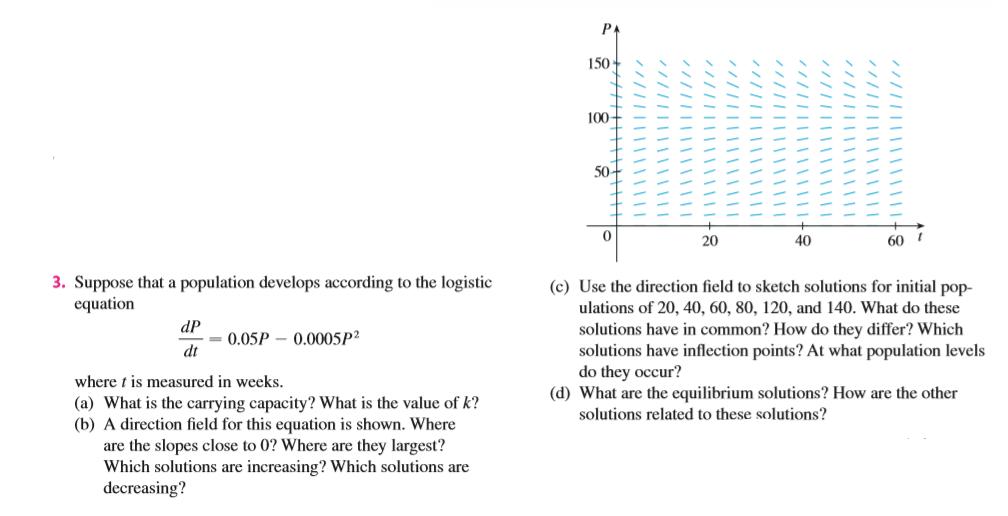150 100 50 20 40 60 3. Suppose that a population develops according to the logistic equation (c) Use the direction field to sketch solutions for initial pop- ulations of 20, 40, 60, 80, 120, and 140. What do these dP = 0.05P - 0.0005P2 dt solutions have in common? How do they differ? Which solutions have inflection points? At what population levels do they occur? (d) What are the equilibrium solutions? How are the other solutions related to these solutions? where t is measured in weeks. (a) What is the carrying capacity? What is the value of k? (b) A direction field for this equation is shown. Where are the slopes close to 0? Where are they largest? Which solutions are increasing? Which solutions are decreasing?
150 100 50 20 40 60 3. Suppose that a population develops according to the logistic equation (c) Use the direction field to sketch solutions for initial pop- ulations of 20, 40, 60, 80, 120, and 140. What do these dP = 0.05P - 0.0005P2 dt solutions have in common? How do they differ? Which solutions have inflection points? At what population levels do they occur? (d) What are the equilibrium solutions? How are the other solutions related to these solutions? where t is measured in weeks. (a) What is the carrying capacity? What is the value of k? (b) A direction field for this equation is shown. Where are the slopes close to 0? Where are they largest? Which solutions are increasing? Which solutions are decreasing?
Chapter6: Exponential And Logarithmic Functions
Section6.8: Fitting Exponential Models To Data
Problem 2TI: Sales of a video game released in the year 2000 took off at first, but then steadily slowed as time...
Related questions
Question

Transcribed Image Text:150
100
50
20
40
60
3. Suppose that a population develops according to the logistic
equation
(c) Use the direction field to sketch solutions for initial pop-
ulations of 20, 40, 60, 80, 120, and 140. What do these
dP
= 0.05P - 0.0005P2
dt
solutions have in common? How do they differ? Which
solutions have inflection points? At what population levels
do they occur?
(d) What are the equilibrium solutions? How are the other
solutions related to these solutions?
where t is measured in weeks.
(a) What is the carrying capacity? What is the value of k?
(b) A direction field for this equation is shown. Where
are the slopes close to 0? Where are they largest?
Which solutions are increasing? Which solutions are
decreasing?
Expert Solution
This question has been solved!
Explore an expertly crafted, step-by-step solution for a thorough understanding of key concepts.
This is a popular solution!
Trending now
This is a popular solution!
Step by step
Solved in 7 steps with 5 images

Recommended textbooks for you


Algebra & Trigonometry with Analytic Geometry
Algebra
ISBN:
9781133382119
Author:
Swokowski
Publisher:
Cengage


Algebra & Trigonometry with Analytic Geometry
Algebra
ISBN:
9781133382119
Author:
Swokowski
Publisher:
Cengage